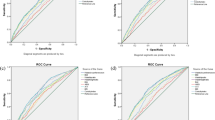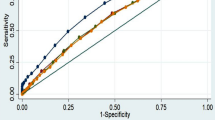Abstract
BACKGROUND:
Body mass index (BMI) and waist circumference are highly correlated. One or the other predicts the metabolic syndromes better, depending on characteristic of the population studied, such as age, gender, and ethnicity. We examined the impact of isolated central obesity, isolated BMI elevation, and the combined type of obesity on metabolic disorders, in order to shed lights on the strategy of obesity screening.
METHODS:
The study subjects were Chinese aged 20 or above residing in Taiwan. Their data were derived from two large-scale studies: the Nutrition and Health Survey in Taiwan (NAHSIT 1993–1996) and the Cardiovascular Disease Risk Factor Two-township Study (CVDFACTS, 1994–1997). In evaluating the relations between obesity and health risks, the cut-points of BMI (≥24 kg/m2 for overweight) and waist circumference (≥80 cm for women and ≥90 cm for men) recommended by Department of Health in Taiwan for Taiwanese people were used to define various types of obesity.
RESULTS:
We found that there was a small but nontrivial proportion (1.7% for men and 4.0% for women) of Taiwanese people for whom BMI was in the normal range but their waist circumferences were above normal. These people were at a higher risk of developing metabolic syndromes than those with isolated BMI elevation. Their risks were close to that of the combined type.
CONCLUSIONS:
In order to screen out high-risk obese individuals, isolated centrally obese subjects should not be overlooked. Therefore, we recommend to assess waist circumference in parallel to, not just sequential to the measurement of BMI in Chinese.
This is a preview of subscription content, access via your institution
Access options
Subscribe to this journal
Receive 12 print issues and online access
$259.00 per year
only $21.58 per issue
Buy this article
- Purchase on SpringerLink
- Instant access to full article PDF
Prices may be subject to local taxes which are calculated during checkout
Similar content being viewed by others
References
Ford ES, Williamson DF, Liu S . Weight change and diabetes incidence: findings from a national cohort of US adults. Am J Epidemiol 1997; 146: 214–222.
Hubert HB, Feinleib M, McNamara PM, Castelli WP . Obesity as an independent risk factor for cardiovascular disease: a 26-year follow-up of participants in the Framingham Heart Study. Circulation 1983; 67: 968–977.
Lipton RB, Liao Y, Cao G, Cooper RS, McGee D . Determinants of incident non-insulin-dependent diabetes mellitus among blacks and whites in a national sample. The NHANES I Epidemiologic Follow-up Study. Am J Epidemiol 1993; 138: 826–839.
Paccaud F, Schluter-Fasmeyer V, Wietlisbach V, Bovet P . Dyslipidemia and abdominal obesity: an assessment in three general populations. J Clin Epidemiol 2000; 53: 393–400.
Gallagher D, Visser M, Sepulveda D, Pierson RN, Harris T, Heymsfield SB . How useful is body mass index for comparison of body fatness across age, sex, and ethnic groups? Am J Epidemiol 1996; 143: 228–239.
Okosun IS, Liao Y, Rotimi CN, Prewitt TE, Cooper RS . Abdominal adiposity and clustering of multiple metabolic syndrome in White, Black and Hispanic Americans. Ann Epidemiol 2000; 10: 263–270.
Fujimoto WY, Newell-Morris LL, Grote M, Bergstrom RW, Shuman WP . Visceral fat obesity and morbidity: NIDDM and atherogenic risk in Japanese American men and women. Int J Obes Relat Metab Disord 1991; 15 (Suppl 2): 41–44.
Visscher TL, Seidell JC, Molarius A, van der Kuip D, Hofman A, Witteman JC . A comparison of body mass index, waist–hip ratio and waist circumference as predictors of all-cause mortality among the elderly: the Rotterdam study. Int J Obes Relat Metab Disord 2001; 25: 1730–1735.
Charlton KE, Schloss I, Visser M, Lambert EV, Kolbe T, Levitt NS, Temple N . Waist circumference predicts clustering of cardiovascular risk factors in older South Africans. Cardiovasc J S Africa 2001; 12: 142–150.
Van Pelt RE, Evans EM, Schechtman KB, Ehsani AA, Kohrt WM . Waist circumference vs body mass index for prediction of disease risk in postmenopausal women. Int J Obes Relat Metab Disord 2001; 25: 1183–1188.
Dobbelsteyn CJ, Joffres MR, MacLean DR, Flowerdew G . A comparative evaluation of waist circumference, waist-to-hip ratio and body mass index as indicators of cardiovascular risk factors. The Canadian Heart Health Surveys. Int J Obes Relat Metab Disord 2001; 25: 652–661.
Turcato E, Bosello O, Francesco VD, Harris TB, Zoico E, Bissoli L, Fracassi E, Zamboni M . Waist circumference and abdominal sagittal diameter as surrogates of body fat distribution in the elderly: their relation with cardiovascular risk factors. Int J Obes Relat Metab Disord 2000; 24: 1005–1010.
Teh BH, Pan WH, Chen CJ . The reallocation of body fat toward the abdomen persists to very old age, while body mass index declines after middle age in Chinese. Int J Obes Relat Metab Disord 1996; 20: 683–687.
Ito H, Ohshima A, Ohto N, Ogasawara M, Tsuzuki M, Takao K, Hijii C, Tanaka H, Nishioka K . Relation between body composition and age in healthy Japanese subjects. Eur J Clin Nutr 2001; 55: 462–470.
Ho SC, Chen YM, Woo JL, Leung SS, Lam TH, Janus ED . Association between simple anthropometric indices and cardiovascular risk factors. Int J Obes Relat Metab Disord 2001; 25: 1689–1697.
Hu D, Hannah J, Gray RS, Jablonski KA, Henderson JA, Robbins DC, Lee ET, Welty TK, Howard BV . Effects of obesity and body fat distribution on lipids and lipoproteins in nondiabetic American Indians: The Strong Heart Study. Obes Res 2000; 8: 411–421.
Pan WH, Kao MD, Tzeng MS, Yen LL, Hung YT, Li LA, Hsiao SY, Yeh WT, Huang PC . Nutrition and health survey in Taiwan (NAHSIT) 1993–1996: design, contents, and operations. Nutr Sci J 1999; 24: 1–8.
Chang HY, Pan WH, Yeh WT, Tsai KS . Hyperuricemia and gout in Taiwan: results from the Nutritional and Health Survey in Taiwan (1993–96). J Rheumatol 2001; 28: 1640–1646.
Yeh CJ, Pan WH, Bai CH, You MS, Wang WC, Wang LY, Lee TK . Curvilinear relations between age and hemostatic parameters in Chinese. Thromb Haemost 1994; 72: 239–243.
Pan WH, Flegal KM, Chang HY, Yeh WT, Yeh CJ, Lee WC . Body mass index and obesity-related metabolic disorders in Taiwanese and US whites and blacks: implications for definitions of overweight and obesity for Asians. Am J Clin Nutr 2004; 79: 31–39.
Alberti KG, Zimmet PZ . Definition, diagnosis and classification of diabetes mellitus and its complications. Part 1: diagnosis and classification of diabetes mellitus provisional report of a WHO consultation. Diabet Med 1998; 15: 539–553.
Stevens J, Knapp RG, Keil JE, Verdugo RR . Changes in body weight and girths in black and white adults studied over a 25 year interval. Int J Obes 1991; 15: 803–808.
Perissinotto E, Pisent C, Sergi G, Grigoletto F . Anthropometric measurements in the elderly: age and gender differences. Br J Nutr 2002; 87: 177–186.
Baik I, Ascherio A, Rimm EB, Giovannucci E, Spiegelman D, Stampfer MJ, Willett WC . Adiposity and mortality in men. Am J Epidemiol 2000; 152: 264–271.
Rimm EB, Stampfer MJ, Giovannucci E, Ascherio A, Spiegelman D, Colditz GA, Willett WC . Body size and fat distribution as predictors of coronary heart disease among middle-aged and older US men. Am J Epidemiol 1995; 141: 1117–1127.
Lahmann PH, Lissner L, Gullberg B, Berglund G . A prospective study of adiposity and all-cause mortality: the Malmo Diet and Cancer Study. Obes Res 2002; 10: 361–369.
Vajo Z, Terry JG, Brinton EA . Increased intra-abdominal fat may lower HDL levels by increasing the fractional catabolic rate of Lp A-I in postmenopausal women. Atherosclerosis 2002; 160: 495–501.
Ferrannini E . Physiological and metabolic consequences of obesity. Metabolism 1995; 9: 15–17.
Baumgartner RN, Heymsfield SB, Roche AF . Human body composition and the epidemiology of chronic disease. Obes Res 1995; 3: 73–95.
Acknowledgements
The survey was supported by grants (DOH-83-FS-41, DOH-84-FS-11, DOH-85-FS-11, DOH-86-FS-11, and DOH-83-TD-015, DOH-84-TD-006) from Department of Health, Taiwan, Republic of China, and grant (NHRI-EX93-9225PP) from National Health Research Institute, Taipei, Taiwan.
Author information
Authors and Affiliations
Corresponding author
Rights and permissions
About this article
Cite this article
Yeh, WT., Chang, HY., Yeh, CJ. et al. Do centrally obese Chinese with normal BMI have increased risk of metabolic disorders?. Int J Obes 29, 818–825 (2005). https://doi.org/10.1038/sj.ijo.0802975
Received:
Accepted:
Published:
Issue Date:
DOI: https://doi.org/10.1038/sj.ijo.0802975



